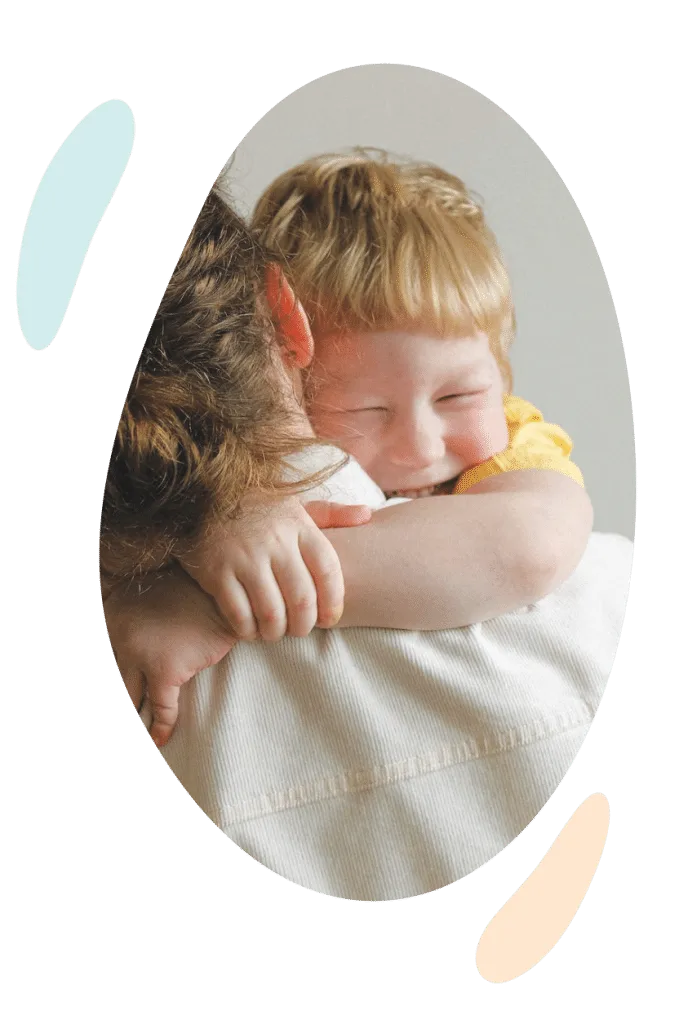
Understanding
Attachment
Disorders
Understanding
Attachment
Disorders
Attachment issues arise from disruptions in the early caregiver-child bond. Undoubtedly, these disruptions significantly affect someones’ ability to trust in others or feel safe in relationships. However, when a caregiver consistently doesn’t fulfill their child’s emotional needs or displays abusive or neglectful behavior, the child may develop an attachment disorder.
Child attachment disorders can significantly impact a child’s social and cognitive development, making it difficult to form healthy relationships later in life. Furthermore, when a child with an attachment disorder doesn’t receive treatment, they may develop an adult attachment disorder.
Still, it’s reassuring to know that treatment options are out there for attachment disorders; therapy and medication are concurrently effective for treating attachment disorders and the conditions that commonly co-occur.
To answer any questions you may have on attachment issues, this article will cover:
- What an attachment disorder is (including how it differs from attachment issues)
- A description of attachment theory
- Types of attachment disorders
- Symptoms of attachment issues and attachment disorders
- Causes and risk factors of attachment disorders
- Treatment options for attachment issues
Do you know your attachment style?
Take our attachment quiz and find out now – fast, easy, free.

What Is an Attachment Disorder?
You may be wondering what attachment issues are. And whether they’re interchangeable with attachment disorders. Let’s break it down.
Attachment Issues
Disruptions in the development of a healthy bond between a child and their primary caregiver(s) can cause attachment issues, meaning the child may struggle with:
- Forming meaningful relationships
- Maintaining a positive sense of self
- Regulating their emotions
An attachment disorder, on the other hand, is more than just “attachment issues.”
Attachment Disorders
Attachment disorders are a severe form of attachment issue that can significantly impact someone’s ability to function in daily life. Those with an attachment disorder may show socially inappropriate behaviors or retreat from social interactions, as they don’t know what a healthy relationship looks like. To further understand how these disorders develop, we may need to consider the underpinnings of attachment theory.
Attachment Theory
Attachment theory arose from British psychologist John Bowlby’s revolutionary thinking about the importance of the infant-caregiver bond in human development.
In his post-WWII work with orphaned and homeless children, Bowlby developed the concept that children must experience an intimate, warm, and continuous relationship with their primary caregiver to grow up mentally healthy. He named this concept “attachment theory.”
Bowlby suggested the fundamental elements of attachment theory to be the following:
As human beings, we have an innate drive to connect with others and form secure relationships.
How a caregiver treats their child will significantly impact the child’s social and cognitive development.
Early attachment experiences influence later relationships.
When a child doesn’t receive this warm, continuous, and intimate bond with their caregiver, attachment issues can develop. And when a child receives abuse or neglect from their primary caregiver, or if their emotional needs consistently go unmet, the child may develop an emotional attachment disorder.
Attachment issues and disorders can influence a child’s ability to regulate their emotions and form healthy relationships. It can also put them at a higher risk of developing mental health issues and behavioral problems. However, the exact influence we see differs on the child’s attachment disorder.
Types of Attachment Disorders
When a caregiver consistently doesn’t meet their child’s basic emotional needs, the child may develop a childhood attachment disorder. If a child with an attachment disorder continues through life without treatment, an adult attachment disorder may develop.
The home environment that causes each childhood attachment disorder may outwardly look similar, but the symptoms of each disorder are vastly different, as is apparent from the following descriptions:
Reactive Attachment Disorder (RAD)
Reactive attachment disorder is an attachment disorder in children. Children with RAD typically try to remove themselves from social interaction as they see relationships as unsafe. These children often become withdrawn, unresponsive, and excessively independent.
Disinhibited Social Engagement Disorder (DSED)
Disinhibited social engagement disorder is another form of child attachment disorder. Children with DSED may be highly sociable. For example, such children are typically overly friendly, past the boundaries of regular social interaction. They may also be extremely friendly to strangers, potentially putting themselves in dangerous situations.

Adult Attachment Disorder (AAD)
This attachment disorder develops when a child with a reactive or disinhibited social engagement disorder doesn’t receive treatment. An adult attachment disorder is a continuation of a previous attachment disorder, so the person will show similar symptoms as they did in childhood, but these symptoms will instead affect their adult relationships.
When less severe disruptions occur in early relationships, a person may develop an insecure attachment style (rather than an attachment disorder). In adulthood, we split the insecure attachment styles into:
- Anxious attachment (or anxiety attachment disorder)
- Avoidant attachment (or avoidant attachment disorder)
- Disorganized attachment (or disorganized attachment disorder)
You can learn more about attachment styles in our article, Attachment Styles & Their Role in Relationships.
And if you don’t yet know your attachment style, you can find out using our website’s free attachment styles quiz.

Attachment Disorders Symptoms and Diagnosis
Everyone’s experience of attachment issues and attachment disorders is different, and the symptoms may show up in different ways. Yet, people with the same attachment style or disorder tend to show similar patterns of behavior, allowing us to identify the common signs. To help clarify the differences between attachment issues and attachment disorders, we outline these common patterns below.

Signs You Have Attachment Issues
The signs of attachment issues differ depending on your attachment style; avoidant, anxious, or disorganized. The following are the symptoms of each style:
Signs of avoidant attachment issues may include:
- Avoidance of physical contact like hugging.
- Difficulty seeking comfort from others when upset or distressed.
- Lack of trust in others.
- Tendency to minimize or suppress emotions.
Signs of anxious attachment issues include:
- Strong desire for closeness and intimacy in relationships, often leading to a fear of rejection or abandonment.
- Difficulty trusting others, and often feeling insecure in relationships.
- Need for frequent reassurance and validation from close others, such as partners.
- Overanalysis of social interactions.
Signs of disorganized attachment issues typically include:
- Difficulty regulating emotions, including extreme mood swings, dissociation, and numbness.
- Feeling overwhelmed and disconnected from one’s own feelings and needs.
- Problems forming close relationships and trusting others.
- Use of self-destructive behaviors and unhealthy coping strategies, such as risky sexual behavior.
Attachment Disorder Symptoms
As we know, the signs of each attachment disorder differ. The Diagnostic and Statistical Manual of Mental Disorders (DSM), a handbook used by healthcare professionals in the US to diagnose mental disorders, provides a classification for RAD and DSED.
Below, you’ll find the DSM-5 criteria for each attachment disorder.
The DSM-5 criteria for RAD
- Repetitive pattern of emotionally withdrawn behavior toward caregivers. The child may display this behavior by not seeking comfort when in distress or not responding to their caregiver’s attempts to comfort them.
- Persistent social and emotional issues. These issues may manifest as a lack of responsiveness to others, an absence of positive reactions during social interactions, or frequent episodes of irritability, sadness, or fearfulness, even in safe environments.
- Caregiver persistently doesn’t meet their child’s emotional needs for comfort, affection, and stimulation, or there are repeated changes in primary caregivers, limiting the child’s ability to form secure attachments.
- No clinical diagnosis of autism spectrum disorder.
- Child must be over nine months of age.
The DSM-5 criteria for DSED
- Consistent pattern of the child actively approaching and engaging with unfamiliar adults with little or no hesitation, using overly familiar verbal or physical behavior, displaying a low tendency to check back with their primary caregiver, and a willingness to go with an unfamiliar adult without hesitation.
- The child has experienced a consistent pattern of inadequate care involving persistent social neglect or deprivation, repeated changes in primary caregivers, or atypical settings that make forming secure attachments challenging.
- Symptoms include not only impulsivity (characteristic of Attentional Deficit Hyperactivity Disorder) but also disinhibited social behavi.
- Child must be over nine months of age.
Causes and Risk Factors of Attachment Disorders
When considering the risk factors of and appropriate treatment for attachment disorders, it’s important to analyze what causes attachment issues–and why they develop into disorders. According to the American Psychology Association, for an attachment disorder to develop, a person must experience severe emotional neglect or insufficient early care. There are certain risk factors in the home environment that increase the likelihood of attachment issues and subsequent disorders.
The risk factors for attachment disorders typically fall into two main categories:
- Factors that prevent a caregiver from showing consistent availability;
- Factors that inhibit the caregiver’s ability to meet the child’s emotional, physical, and psychological needs.
Let’s discuss each in turn.
Factors Preventing a Caregiver From Showing Consistent Availability
When we talk about the consistent availability of a caregiver, we’re referring to their ability to meet their child’s needs and repeatedly support them emotionally over time. Children are at a higher risk of developing an attachment disorder when this consistent availability isn’t present.
Various factors may prevent a caregiver from showing consistent availability. For example, children may experience a blockage to attachment security when frequently moved around in foster care or when placed in institutional care.
Another factor that puts children at a higher risk of developing an attachment disorder is the loss of a primary caregiver. This loss could be through death, imprisonment, or voluntarily leaving. The sudden loss of an important attachment figure can leave a child feeling like the world isn’t a secure place and that people can leave at any moment. This sense of insecurity and doubt can make relationships feel unsafe.

Factors Inhibiting the Caregiver’s Ability to Meet the Child’s Needs
A primary caregiver may be unable to meet their child’s emotional needs for various reasons. Firstly, they may have an insecure attachment style themselves. If a caregiver’s parents never modeled the correct behavior to them as children, they typically don’t understand how to act appropriately to their own children. Furthermore, a caregiver who has experienced severe abuse or neglect often finds providing adequate care for their child more challenging. As a result of their chaotic childhood, they may have unsafe or inaccurate representations of love and care.
A caregiver experiencing mental health concerns can also find meeting their child’s needs difficult. For example, maternal depression symptoms during pregnancy can impact the prenatal attachment bond between mother and baby. And when depressive symptoms extend into the postnatal stage, the mother-baby bond is less likely to be secure than in non-depressed mothers.
We see similar findings with maternal anxiety, bipolar disorder, and schizophrenia. Babies are more prone to develop attachment insecurity if their primary caregiver is severely affected by these mental health concerns.
Other factors that may inhibit a caregiver’s ability to meet their child’s needs are:
- Domestic violence between caregivers
- Physical illness
- Substance abuse concerns
- Separation or divorce
- Child maltreatment (such as sexual, physical, emotional, or medical abuse or neglect)
Treatment for Attachment Disorders
The treatment options for attachment disorders differ depending on the severity of the disorder, a person’s age, and their individual needs. However, there are some common treatment options available for attachment disorders.
Psychotherapy
Psychotherapy, also known as talk therapy, can help those with an attachment disorder understand what a healthy, non-judgmental relationship looks and feels like. Talk therapy can also help individuals with an attachment disorder become more aware of their emotions, behaviors, and attachment patterns, as well as how these influence their relationships.
The main forms of psychotherapy for attachment disorders are:
- Attachment-based therapy
- Play therapy
- Cognitive-behavioral therapy
- Family therapy

Medication
Medication isn’t frequently used as a primary treatment for attachment disorders because these conditions manifest from relational issues. However, medication can help reduce the symptoms of conditions that commonly co-occur with attachment problems, like depression and anxiety. It’s important to speak to a medical professional regarding your symptoms, as they will help guide you on the most appropriate route of treatment for your needs.

Final Words on Attachment Disorders
Home environments where a child experiences severe disruptions in their relationship with their caregiver can significantly impact their social and cognitive development. In the cases of neglect or abuse, a child may develop a reactive attachment disorder or disinhibited social engagement disorder.
Attachment disorder symptoms typically include difficulties forming healthy relationships, developing a positive sense of self, and regulating emotions. If a childhood attachment disorder goes untreated, these symptoms may extend into adulthood, known as an adult attachment disorder.
The good news is that therapy and medication can effectively treat attachment disorders, helping individuals form and maintain healthy outlooks and relationships in adulthood. By understanding attachment disorders, we can better identify the signs, seek proper treatment, and support those struggling with these problems.
American Psychiatric Association. (1994). Diagnostic and statistical manual of mental disorders (5th ed.). American Psychiatric Association.
American Psychiatric Association. (2013). Diagnostic and statistical manual of mental disorders (5th ed.). American Psychiatric Association.
Attachment and child development | NSPCC Learning. (n.d.). NSPCC Learning
Hornor G. (2019). Attachment Disorders. Journal of pediatric health care: official publication of National Association of Pediatric Nurse Associates & Practitioners, 33(5), 612–622.
Humphreys, K. L., Nelson, C. A., Fox, N. A., & Zeanah, C. H. (2017). Signs of reactive attachment disorder and disinhibited social engagement disorder at age 12 years: Effects of institutional care history and high-quality foster care. Development and psychopathology, 29(2), 675–684.
Kroupina, M. G., Ng, R., Dahl, C. M., Nakitende, A. J., & Elison, K. C. (2022). Reactive Attachment Disorder (RAD) and Disinhibited Social Engagement Disorder (DSED) Symptomatology in a High-Risk Clinical Sample. Clinical Pediatrics, 000992282211438.
Prior, V., & Glaser, D. (2006). Understanding attachment and attachment disorders: Theory, evidence and practice. Jessica Kingsley Publishers.
Rollè, L., Giordano, M., Santoniccolo, F., & Trombetta, T. (2020). Prenatal Attachment and Perinatal Depression: A Systematic Review. International journal of environmental research and public health, 17(8), 2644.
Seim, A. R., Jozefiak, T., Wichstrøm, L., Lydersen, S., & Kayed, N. S. (2020). Reactive attachment disorder and disinhibited social engagement disorder in adolescence: co-occurring psychopathology and psychosocial problems. European Child & Adolescent Psychiatry, 31(1), 85–98.
Śliwerski, A., Kossakowska, K., Jarecka, K., Świtalska, J., & Bielawska-Batorowicz, E. (2020). The Effect of Maternal Depression on Infant Attachment: A Systematic Review. International journal of environmental research and public health, 17(8), 2675.
Stevenson-Hinde, J., Chicot, R., Shouldice, A., & Hinde, C. A. (2013). Maternal anxiety, maternal sensitivity, and attachment. Attachment & human development, 15(5-6), 618–636.








 Get mental health tips straight to your inbox
Get mental health tips straight to your inbox